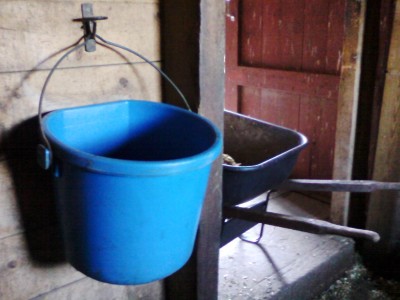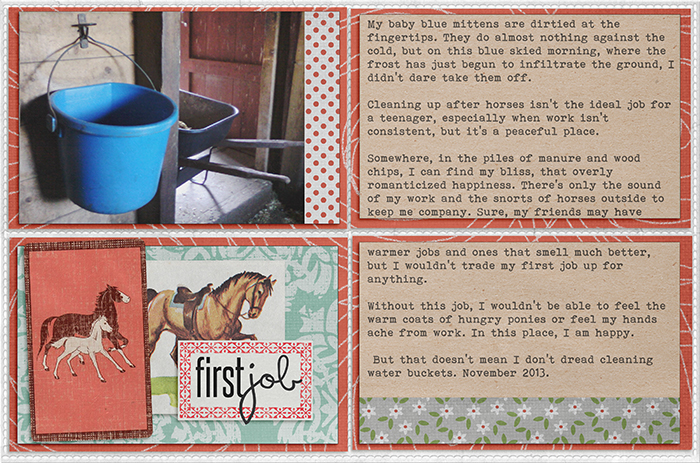
Teenager Emily Sagnella, used this photo taken with her phone and the Story Swoop tool to tell the story of a chilly early morning at work and what having this job means to her right now.
See how teenager Emily Sagnella tells the story of a chilly early morning at work and what this job means to her right now. She used a photo taken with her camera phone and the Story Swoop prompts and writing guide.
Below are the 4 story writing steps in Story Swoop. NOTE: When you use Story Swoop, you’ll get a writing guide with THREE COLUMNS. The third column (not shown below) will show your prompted notes.
WRITE STEP 1: Introduce the story with detail presented in a way that reflects your feelings/mood.
[twocol_one]
Consider how the photo makes you feel.
Consider the specific details you recorded.
Pick out a detail that you can present in a way that’s congruent with this feeling, in a way that evokes a mood or sets a tone, and do it in sentence 1.
For example: If you are worried, is there something in the environment that’s worrisome? Perhaps a loose shingle on the roof or an unweeded garden. If you are tired, is the sun hot and hurting your eyes? Perhaps you’re optimistic, and the weather is awesome, or you get a taxi right away—it pulls smoothly up next to you validating your optimism!
HERE’S AN EXAMPLE
photo and story by Emily Sagnella

My baby blue mittens are dirtied at the fingertips. They do almost nothing against the cold, but on this blue skied morning, where the frost has just begun to infiltrate the ground, I didn’t dare take them off.
Emily’s description of her mittens, the mention of the cold weather and the inclusion of a “blue-skied morning” along with the photo immediately suggest that she’s working or doing something outside, in a barn, during the winter. That she notices the “blue-skied morning” adds a sense of optimism and well-being. While the mittens aren’t in this photo, they are a concrete detail that come from the moment when the photo was taken. They are a part of the story and they add more context to the photo. The photo and the words work together to tell this story.
WRITE STEP 2: Set the context
[twocol_one]
Introduce the micro (the current story) within the macro context (your life right now).
Make clear the who, what, where, and/or when of the situation. Try to convey not only the immediate moment of the photo but the larger context of your life right now. Use simple and clear details.
HERE’S AN EXAMPLE
Cleaning up after horses isn’t the ideal job for a teenager, especially when work isn’t consistent, but it’s a peaceful place.
In just one sentence, Emily conveys
- the immediate situation: cleaning up after horses
- and the larger context: a teenager with a job that’s not ideal and yet necessary
WRITE STEP 3: Tell the rest of the story and/or details of the photo.
[twocol_one]
Explore what it means that you have the feelings this photo evokes. Use specific details from the photo, the situation, and your life to explore this.
If you have a story to tell, tell it! Put your characters “on stage” (in other words show us their setting with concrete details). Have them speak (but only the words that are key to the story — we don’t need a whole lot of extraneous chat).
Somewhere, in the piles of manure and wood chips, I can find my bliss, that overly romanticized happiness. There’s only the sound of my work and the snorts of horses outside to keep me company. Sure, my friends may have warmer jobs and ones that smell much better, but I wouldn’t trade my first job up for anything.
Emily continues writing about what it is to be doing the work of taking care of horses on a cold winter morning. She also considers what it is to have this particular job and how it’s not ideal — and yet it’s hers and she’s glad of that. She uses concrete details that can be seen, felt, heard and smelled. Appealing to multiple senses makes the story more clear and gives her great memory triggers in future years.
WRITE STEP 4: Finish with connection to how this photo makes you feel.
[twocol_one] Finish it up with something that connects to how the photo makes you feel. Prior to this, you’ve been encouraged to use concrete and specific details as a way to reveal abstract feelings like happiness or worry or exhaustion. Now you’ve earned the ability to just say it — I’m tired! or I’m happy! Say it and gives a final look at why this is so. Take a look back through what you’ve written and see if you can add your voice and attitude in — or that of others in your story.
[/twocol_one] [twocol_one_last] Without this job, I wouldn’t be able to feel the warm coats of hungry ponies or feel my hands ache from work. In this place, I am happy. But that doesn’t mean I don’t dread cleaning water buckets. Emily finishes with concrete details that appeal to the reader’s sense of touch and that continue to ground the story in the real world. And then she tells us how she feels. When you use the right details you can use abstracts like “happiness” and the reader really believes it — even more, when you read this later, YOU believe it and are taken back to this earlier time in your life. Her last line is a fun ending that shows off and records her personality and attitude. Imagine being able to read something that your mother or grandmother had written like this that really records the world she was living in and how she felt about it.
[/twocol_one_last]

First Job Photo and Story by Emily Sagnella; Supplies: Pocket page and Life’s A Ride Kit by Valerie Wibbens.
Here is Emily’s photo and story slipped into a pocket page. What photo do you have on your phone that needs its story told? Share in the comments. If you’re not using Story Swoop, check it out now. If you are using it, tell us how it’s going.
Story Swoop is not just for scrapbookers. If you are a social-sharing, instagramming photo taker, this is a tool you can use to ensure the stories that go with quickly snapped moments aren’t lost. All examples in this series are photos and stories from teenagers who are not scrapbookers. Click here to read the other articles in this series about photo-focused storytelling with Story Swoop. Read on to see an example of the writing guide at work.

